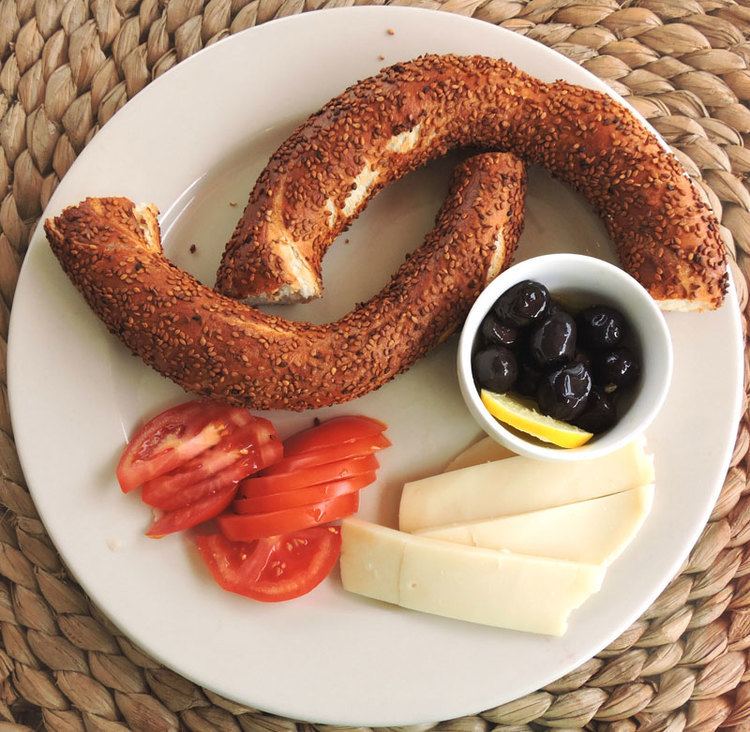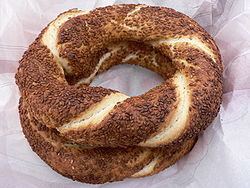 | ||
Main ingredients Dough (flour, water, yeast, salt), sesameseeds, molasses Similar Pogača, Börek, Qurabiya, Tsoureki, Kandil simidi | ||
Turkish sesame bagel simit recipe ring bread
Simit (Turkish: simit, Arabic: سميط, samītˤ, Persian: سیمیت, sīmītˤ, Bulgarian: симит /simit/), gevrek (Turkish: gevrek, Bulgarian: геврек, Macedonian: ѓеврек, Serbian: ђеврек), bokegh (Armenian: բոկեղ), or koulouri (Greek: κουλούρι) is a circular bread, typically encrusted with sesame seeds or, less commonly, poppy, flax or sunflower seeds, found across the cuisines of the former Ottoman Empire, and the Middle East. Simit's size, crunch, chewiness, and other characteristics vary slightly by region.
Contents
- Turkish sesame bagel simit recipe ring bread
- Turkish sesame bread simit episode 149 baking with eda
- Name
- Origins
- Consumption
- Similar products
- References

In İzmir, simit is known as gevrek ("crisp"), although it is very similar to the Istanbul variety. Simits in Ankara are smaller and crisper than those of other cities. Simits in Istanbul are made with molasses.

Turkish sesame bread simit episode 149 baking with eda
Name
The word simit comes from Arabic samīd (سميد) "white bread" or "fine flour".

Other names are based on the Greek koulouri (κουλούρι): Aramaic qeluro/qelora; or the Turkish gevrek: South Slavic đevrek, ђеврек, gjevrek, ѓеврек, геврек. The Armenian name is բոկեղ [bokegh]. In Judaeo-Spanish it is known as roskas turkas.
Origins

Simit has a long history in Istanbul. Archival sources show that the simit has been produced in Istanbul since 1525. Based on Üsküdar court records (Şer’iyye Sicili) dated 1593, the weight and price of simit was standardized for the first time. The 17th-century traveler Evliya Çelebi wrote that there were 70 simit bakeries in Istanbul during the 1630s. Jean Brindesi's early 19th-century oil paintings about Istanbul daily life show simit sellers on the streets. Warwick Goble, too, made an illustration of these simit sellers of Istanbul in 1906. Simit and its variants became popular across the Ottoman Empire.
Consumption

Simit is generally served plain, or for breakfast with tea, fruit preserves, or cheese or ayran. Drinking tea with simit is traditional. Simit ("Bokegh" in Armenian) is a traditional Christmas bread in Armenia.

Simits are sold by street vendors in Turkey, who either have a simit trolley or carry the simit in a tray on their head. Street merchants generally advertise simit as fresh ("Taze simit!"/"Taze gevrek!") since they are baked throughout the day; otherwise hot ("Sıcak, sıcak!") and extremely hot ("El yakıyor!" means "It burns the hand!") when they are not long out of the oven.
Simit is an important symbol for lower and middle-class people of Turkey. Sometimes it is called susam kebabı ("sesame kebab").
In other parts of the middle east it is consumed with boiled eggs and /or duggah which is a mixture of herbs used as condiments ,it is commonly used as a break of fast in holy makkah and Madeenah mosques with yougurt or buttermilk.
Similar products
Certain varieties of Romanian covrigi are similar to simit.
Another type of bread similar to simit is known as obwarzanek (in particular obwarzanek krakowski) in Poland and bublik in Russia, Ukraine and Belarus. The main difference is that the rings of dough are poached briefly in boiling water prior to baking (similarly to bagels), instead of being dipped in water and molasses syrup, as is the case with simit.
Girde (Uygur: Гирде), is a type of bread baked on the walls of tandoori oven, that is very similar to simit, and that the uygur türks in China see as a characteristic item in their culture specific kitchen.
